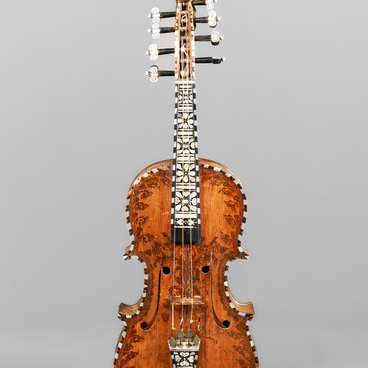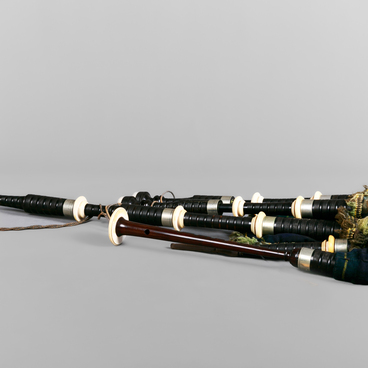The Chuvash bagpipe, known as the “shybr, ” or the “shapar, ” is a woodwind instrument with two single reeds. The instrument from the museum’s collection was manufactured in 1984 by the craftsman Vasily Russkov from the Verkhniye Achaki village, Yadrinsky District, Chuvashia.
This shybr has a traditional design. The air reservoir is a bag made from a cow’s stomach. Before the instrument is played, the bag is usually soaked in water to ensure that it is stretchable and airtight. The bag is equipped with a short bone pipe for air supply and two metal chanters, one of which has two holes and the other — four holes.
The chanters are combined into a common bell made of a cow horn. The reeds are made of cane or goose quill. The musician holds the instrument in front of the body and presses the bag with the arms to produce a continuous sound. The shybr has a buzzing and sharp tone that can be heard from afar when played outdoors.
The shybr is one of the oldest national instruments of the Chuvash people. In the past, it was used for religious ceremonies. For example, it was played at the spring festival of farmers known as the “plow’s feast, ” and during ceremonies performed to drive away evil spirits.
The shybr was believed to have mystical and magical powers that could be either good or evil. People admired shybr players and were also somewhat terrified by them. A Chuvash bagpiper was called a “shybrs.” Such musicians performed at all folk festivals, events, fairs, weddings, and funerals.
They played a particularly important role at weddings. The ceremony itself was opened with the sound of the bagpipe. After that, a shybrs riding a horse accompanied the groom as he went to bring the bride. During the wedding, the musician was placed on a special elevated platform. Before the bride’s song, a special shybr overture was played, and then the song itself was accompanied by a shybr melody.
If there were two bagpipers at a wedding, one of whom represented the bride, and the other — the groom, they would often hold a musical duel to see who could play longer without a rest. According to a Chuvash proverb,
This shybr has a traditional design. The air reservoir is a bag made from a cow’s stomach. Before the instrument is played, the bag is usually soaked in water to ensure that it is stretchable and airtight. The bag is equipped with a short bone pipe for air supply and two metal chanters, one of which has two holes and the other — four holes.
The chanters are combined into a common bell made of a cow horn. The reeds are made of cane or goose quill. The musician holds the instrument in front of the body and presses the bag with the arms to produce a continuous sound. The shybr has a buzzing and sharp tone that can be heard from afar when played outdoors.
The shybr is one of the oldest national instruments of the Chuvash people. In the past, it was used for religious ceremonies. For example, it was played at the spring festival of farmers known as the “plow’s feast, ” and during ceremonies performed to drive away evil spirits.
The shybr was believed to have mystical and magical powers that could be either good or evil. People admired shybr players and were also somewhat terrified by them. A Chuvash bagpiper was called a “shybrs.” Such musicians performed at all folk festivals, events, fairs, weddings, and funerals.
They played a particularly important role at weddings. The ceremony itself was opened with the sound of the bagpipe. After that, a shybrs riding a horse accompanied the groom as he went to bring the bride. During the wedding, the musician was placed on a special elevated platform. Before the bride’s song, a special shybr overture was played, and then the song itself was accompanied by a shybr melody.
If there were two bagpipers at a wedding, one of whom represented the bride, and the other — the groom, they would often hold a musical duel to see who could play longer without a rest. According to a Chuvash proverb,




